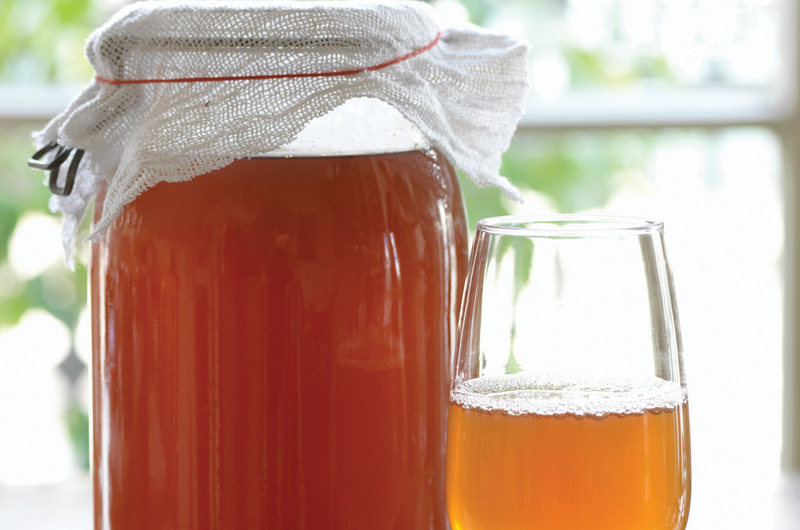When visiting a friend’s kitchen, sometimes you just can’t resist sampling a slice of freshly baked bread or a finger full of cream-cheese frosting, offered or not. In the haste to try someone’s culinary treats, however, you may have overlooked the large jar of kombucha steeping ominously on the counter. Despite the fact that this drink has a devout Island following of brewers and consumers, many of the uninitiated remain too wary to ask for a taste.
The fermented beverage can be traced back to numerous ancient origins, including nineteenth-century Russia, where it was one of several fermented teas called kvass, and ancient China, where it was sometimes called chameijun or “tea mold.” But the modern-day imbibers of the fizzy drink, brewed with black tea, sugar, and a bacteria-and-yeast culture, could be grouped into two categories: those who brew and those who buy.
That is, until early last summer, when stores stopped selling some popular brands of kombucha because of a concern about elevated alcohol content. All kombucha contains a small amount of alcohol due to the fermentation process, but testing on several brands – including the popular GT’s Organic Raw Kombucha and Synergy – showed levels high enough to cause an alcohol-labeling issue. Numerous vendors around the country stopped selling the drink, including on-Island businesses such as Healthy Additions and Tisbury Farm Market in Vineyard Haven and Alley’s General Store in West Tisbury. But by last fall, most kombucha brands, including GT’s, had resolved the fermentation issue and returned to market shelves.
During the time commercial kombucha was unavailable, however, some former buyers decided to become brewers. It’s one thing to buy kombucha in a bottle and enjoy its fruit-infused flavorings. It’s another to delve into the process of making this strange, brownish-gold liquid that needs to shack up with a pancake-shaped glop for days before it’s ready to be chilled and served. The home-brewed version is steeped in jars with black tea as the base and a “mother culture.” The glop (often mistakenly referred to as the “mushroom”) is actually a “symbiotic collection of bacteria and yeast” (or SCOBY for short) that serves as the catalyst for fermentation. Although the task of home-brewing may seem daunting, the process is actually not labor-intensive and allows the brewer to experiment with a variety of flavors and degrees of fermentation.
Abigail Higgins, who lives in West Tisbury, has been brewing kombucha successfully since 2003 and drinks it almost daily. “I’ve bought GT Dave’s kombucha from time to time. There have been allegations of alcohol, but anything that’s fermented has a small amount of alcohol in it – sourdough bread, sauerkraut,” she says. Abigail enjoys the flavor of her home-brewed version, saying, “It tastes a little bit like cider, a little bit like champagne.”
Her process for brewing kombucha is simple and much more affordable than the commercial variety, where a sixteen-ounce bottle retails for about four dollars. “It’s very expensive [to buy] but you can make it yourself,” says Abigail, who ordered her first SCOBY online from “a guy in New York.” During the fermentation process, the SCOBY multiplies to produce a second SCOBY, and each can be transferred to future batches of kombucha.
“I’ve given many people ‘mushrooms,’ and many have gone on to make fantastic- tasting kombucha,” Abigail says. “One of the traditions of making kombucha is something that is passed around with no money being exchanged. It’s sort of become a commercial enterprise, but the idea of it is that it’s something you share. No one invented it; it invented itself.”
Oceana Rames, a certified naturopath in Vineyard Haven, became familiar with kombucha in 1992 when living on the West Coast. “There was sort of an aura around it in those days, but it wasn’t mass-produced anywhere at that time,” says Oceana. “The big word about kombucha back then was that it was good for your immune system, and I believe the original information about kombucha was right on.”
Roni DeLuz of Vineyard Haven agrees: “I call them power drinks.” The certified naturopath, whose book 21 Pounds in 21 Days: The Martha’s Vineyard Detox Diet is a New York Times best seller, runs a year-round retreat where clients go in search of a natural solution to their fatigue, sickness, or ill health, and undergo an intensive detoxification program. “Kombucha is a great colon drink because it supports repair of the colon wall,” explains Roni, who says the tea is also good for cleansing the body, boosting the immune system, and balancing the digestive tract. “Education is everything. Your tastes seem to change when you understand the information behind what you’re drinking.”
Kombucha contains live bacteria believed to benefit the digestive tract, but no clinical studies on its purported health claims have been published to date, and the bacterial content means imbibers should drink it in moderation. Anyone with a compromised immune system, severe allergies, or other medical issues should consult a health-care practitioner before trying it. That said, the vast majority of kombucha drinkers experience no ill effects whatsoever, and many are strong advocates of its health benefits.
Bea Whiting of West Tisbury had been drinking bottled kombucha for more than two years when she decided to enroll in a make-your-own workshop last June. “I’d known other people who had grown it on their own and had great success,” says Bea, who picked wild stinging nettles on her farm to flavor her first brew.
The workshop Bea attended is one of many offered by Jan Buhrman’s Kitchen Porch Culinary Experiences. Jan started brewing kombucha four years ago as “a way to avoid purchasing juice at the grocery store for my kids – they were guzzling the stuff.” For $45, she guides participants through steps in the brewing process, and they go home with a jar of their first batch – complete with their own SCOBY.
The fun of brewing is that no two kombuchas are alike. Says Bea, “Jan said to taste it and see how you like it. The longer it sits, the fizzier it gets. The kombucha colony that’s growing in the mixture grows off the sugar – the longer you keep it, the more sour it will get. She told us you can take out the culture when the tea gets to the point where you want it, and then start another batch.” Perhaps the most important thing for Bea: “I like the way it tastes.”
Making kombucha
Abigail Higgins shared her process of making kombucha, specifically noting the importance of having a clean preparation area and a healthy, viable SCOBY. For extra safety, use sterilized glass or stainless steel containers for brewing. “Contamination is a danger if you are making kombucha. It could result in some potentially dangerous organisms, but more likely you will get a bad-tasting kombucha. It’s pretty important to store the SCOBY well. Store it in the fridge until you’re ready to use it,” says Abigail.
1. Bring 3 1/2 quarts water to a boil, add 5 British-blend black tea bags (because they have no strings or metal staples), wait 12 to 15 minutes, and then remove tea bags.
2. Stir in 1 cup sugar and let cool. Keep covered until lukewarm and then pour into a large jar, leaving extra room at the top.
3. Add the SCOBY and 1/2 cup (previously brewed) kombucha. Cover the container with a closely woven piece of cloth and secure with a rubber band. Let sit for about 4 days; at that point the SCOBY will have produced another growth at the surface.
4. Remove each SCOBY with some kombucha for future brewing. At this point, you can add flavorings such as ginger, lemon, or honey. Decant the remaining beverage into bottles and refrigerate.







